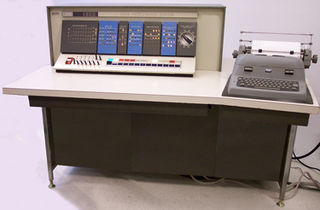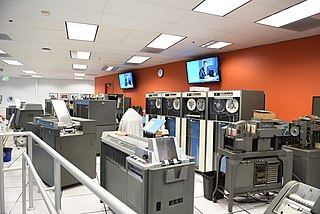

Calcomp plotters (sometimes referred to as CalComp plotters) were the best known products of the California Computer Products company ( Calcomp or CalComp). [1] [2]


Calcomp plotters (sometimes referred to as CalComp plotters) were the best known products of the California Computer Products company ( Calcomp or CalComp). [1] [2]
The Calcomp 565 drum plotter, [3] [4] introduced in 1959, was one of the first computer graphics output devices sold. The computer could control in 0.01 inches (0.25 mm) increments the rotation of an 11-inch (280 mm) wide drum, and the horizontal movement of a pen holder over the drum. The pen was pressed by a spring against paper scrolling across the drum. A solenoid could lift the pen off the paper. This arrangement allowed line drawings to be made under computer control. Later, Calcomp manufactured its model 563, which was very similar but had a 30-inch (760 mm) wide drum.
The paper rolls were 120 feet (37 m) long. A metal bar above the take-up reel allowed a finished plot to be torn off and removed. The drum would then be advanced using the manual controls and the fresh paper end taped to the take-up reel. The standard pen was a ball-point, but liquid ink pens were available, and typically were used for higher quality plots intended for publication. Other paper stock could be taped to the drum if desired. A chart drive switch was provided to turn off the motorized paper supply and take-up reels for this purpose.
IBM marketed the Calcomp 565 as its IBM 1627 [5] for use with its low-end scientific computers, first the IBM 1620, and, later, the IBM 1130. It was perhaps the first non-IBM peripheral that IBM allowed to be attached to one of its computers.
A Calcomp plotter attached to an IBM 1401 was used to develop Bresenham's line algorithm in 1962. [6]

A plotter is a machine that produces vector graphics drawings. Plotters draw lines on paper using a pen, or in some applications, use a knife to cut a material like vinyl or leather. In the latter case, they are sometimes known as a cutting plotter.

Punched tape or perforated paper tape is a form of data storage that consists of a long strip of paper in which holes are punched. It developed from and was subsequently used alongside punched cards, differing in that the tape is continuous.
Bresenham's line algorithm is a line drawing algorithm that determines the points of an n-dimensional raster that should be selected in order to form a close approximation to a straight line between two points. It is commonly used to draw line primitives in a bitmap image, as it uses only integer addition, subtraction and bit shifting, all of which are very cheap operations in commonly used computer instruction sets such as x86_64. It is an incremental error algorithm. It is one of the earliest algorithms developed in the field of computer graphics. An extension to the original algorithm may be used for drawing circles.

The IBM 1620 was announced by IBM on October 21, 1959, and marketed as an inexpensive "scientific computer". After a total production of about two thousand machines, it was withdrawn on November 19, 1970. Modified versions of the 1620 were used as the CPU of the IBM 1710 and IBM 1720 Industrial Process Control Systems.

The IBM 1401 is a variable-wordlength decimal computer that was announced by IBM on October 5, 1959. The first member of the highly successful IBM 1400 series, it was aimed at replacing unit record equipment for processing data stored on punched cards and at providing peripheral services for larger computers. The 1401 is considered to be the Ford Model-T of the computer industry, because it was mass-produced and because of its sales volume. Over 12,000 units were produced and many were leased or resold after they were replaced with newer technology. The 1401 was withdrawn on February 8, 1971.

The IBM 701 Electronic Data Processing Machine, known as the Defense Calculator while in development, was IBM’s first commercial scientific computer and its first series production mainframe computer, which was announced to the public on April 29, 1952. It was invented and developed by Jerrier Haddad and Nathaniel Rochester based on the IAS machine at Princeton.

A magnetic stripe card is a type of card capable of storing data by modifying the magnetism of tiny iron-based magnetic particles on a band of magnetic material on the card. The magnetic stripe, sometimes called swipe card or magstripe, is read by swiping past a magnetic reading head. Magnetic stripe cards are commonly used in credit cards, identity cards, and transportation tickets. They may also contain an RFID tag, a transponder device and/or a microchip mostly used for business premises access control or electronic payment.

The IBM 1627 was a rebranded Calcomp plotter sold by IBM for use with the IBM 1620, and, later, the IBM 1130 computers. It became perhaps the first non-IBM peripheral that IBM allowed to be attached to one of its computers.

The IBM 1132 line printer was the normal printer for the IBM 1130 computer system. It printed 120 character lines at 80 lines per minute. The character set consisted of numbers, upper-case letters and some special characters.

DECtape, originally called Microtape, is a magnetic tape data storage medium used with many Digital Equipment Corporation computers, including the PDP-6, PDP-8, LINC-8, PDP-9, PDP-10, PDP-11, PDP-12, and the PDP-15. On DEC's 32-bit systems, VAX/VMS support for it was implemented but did not become an official part of the product lineup.

The IBM 729 Magnetic Tape Unit was IBM's iconic tape mass storage system from the late 1950s through the mid-1960s. Part of the IBM 7 track family of tape units, it was used on late 700, most 7000 and many 1400 series computers. Like its predecessor, the IBM 727 and many successors, the 729 used 1/2 inch (12.7 mm) magnetic tape up to 2400 feet long wound on reels up to 10½ inch (267 mm) diameter. To allow rapid tape acceleration, long vacuum columns were placed between the tape reels and the read/write heads to absorb sudden increases in tape tension which would otherwise break the tape. Write protection was provided by a removable plastic ring in the back of the tape reel.

The Bendix G-15 is a computer introduced in 1956 by the Bendix Corporation, Computer Division, Los Angeles, California. It is about 5 by 3 by 3 feet and weighs about 966 pounds (438 kg). The G-15 has a drum memory of 2,160 29-bit words, along with 20 words used for special purposes and rapid-access storage. The base system, without peripherals, cost $49,500. A working model cost around $60,000. It could also be rented for $1,485 per month. It was meant for scientific and industrial markets. The series was gradually discontinued when Control Data Corporation took over the Bendix computer division in 1963.

The Teletype Model 33 is an electromechanical teleprinter designed for light-duty office use. It is less rugged and cost less than earlier Teletype machines. The Teletype Corporation introduced the Model 33 as a commercial product in 1963 after being originally designed for the United States Navy. There are three versions of the Model 33:
The ICT 1301 and its smaller derivative ICT 1300 were early business computers from International Computers and Tabulators. Typical of mid-sized machines of the era, they used core memory, drum storage and punched cards, but they were unusual in that they were based on decimal logic instead of binary.

IBM's first magnetic tape data storage devices, introduced in 1952, use what is now generally known as 7 track tape. The magnetic tape is 1/2" wide and there are six data tracks plus one parity track for a total of seven parallel tracks that span the length of the tape. Data is stored as six-bit characters, with each bit of the character and the additional parity bit stored in a different track.

The IBM System/360, announced in 1964, introduced what is now generally known as 9 track tape. The 1⁄2 inch (12.7 mm) wide magnetic tape media and reels are the same size as the earlier IBM 7 track format it replaced, but the new format has eight data tracks and one parity track for a total of nine parallel tracks. Data is stored as 8-bit characters, spanning the full width of the tape. Various recording methods have been employed during its lifetime as tape speed and data density increased, including PE, GCR and NRZI. Tapes come in various sizes up to 3,600 feet (1,100 m) in length.
Magnetic tape data storage is a system for storing digital information on magnetic tape using digital recording.
Calcomp Technology, Inc., often referred to as Calcomp or CalComp, was a company best known for its Calcomp plotters.
DAC-1, for Design Augmented by Computer, was one of the earliest graphical computer aided design systems. Developed by General Motors, IBM was brought in as a partner in 1960 and the two developed the system and released it to production in 1963. It was publicly unveiled at the Fall Joint Computer Conference in Detroit 1964. GM used the DAC system, continually modified, into the 1970s when it was succeeded by CADANCE.
The IBM 7701 Magnetic Tape Transmission Terminal was a communications device announced by IBM in 1960. It was designed to transfer the contents of a reel of magnetic tape over a leased or dial telephone circuit.
The machine in question, a Calcomp 702 plotter
into the CalComp computer
Programmed in Fortran, and plotted off line on a CalComp 565 digital plotter
our CalComp 565 graph plotter (alias IBM 1627)